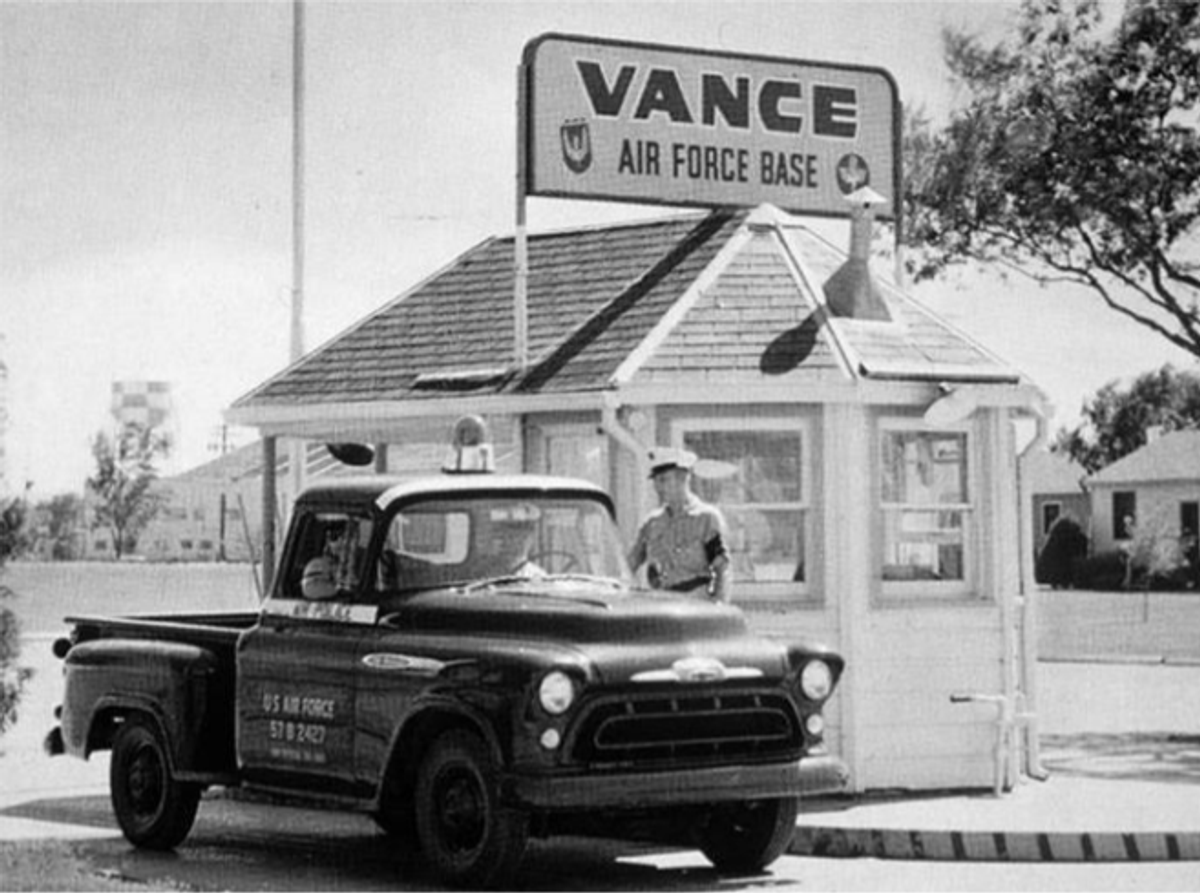HISTORY

Advertisement
Summarized History
In keeping with the Air Force tradition of naming bases for deceased Air Force flyers, on July 9, 1949, the base was renamed after a local World War II hero and Medal of Honor winner, Lt. Col. Leon Robert Vance, Jr. The twin-engine T-37 jet, designed as a primary trainer became operational at the base in 1961. Replacing the T-33 in 1963-64, was the T-38, an advanced supersonic jet trainer. In 1995, the 71st Flying Training Wing moved into a new specialized undergraduate pilot training program with the arrival of the Beechjet T-1 Jayhawk. Joint training with the Navy became a reality in March, 1996, and Navy and Marine Corps student pilots arrived in April 1996, as part of Class 97-08. For more of Vance’s history visit Vance AFB's website, under the "About Us" Tab.Unabridged History
Vance Air Force base history dates back to 1941 when it was originally founded as Air Corps Basic Flying School, Enid, Oklahoma. On 11 February 1942, the base officially became the Enid Army Flying School. Months later the Army changed the name to Enid Army Air Field. After the end of World War II, the War Department inactivated the field on 31 January 1947. Later in 1947, the newly created Air Force, planned to build permanent bases on some of the temporary World War II sites and reopened the installation as a permanent facility on 26 August 1948. Enid AFB became Vance AFB on 9 July 1949. The base was named in honor of Lt Col Leon Robert Vance, Jr., a native of Enid, who was posthumously received the Medal of Honor for gallantry in action over France on 5 June 1944. The 3575th Pilot Training Wing (advanced Multi-Engine) was charged with the care and operation of Vance AFB. The wing’s flying mission was to provide pilot training in multiengine aircraft. The early 1960’s brought multiple changes to the base. First, Vance AFB became one the first base to use contractors to support the wing’s flying operations. Job positions like maintenance and base ops which are normally run by active duty personnel were taken over by civilian contractors. The wing’s mission also changed to training single engine pilots and implemented the Undergraduate Pilot Training Program (UPT). While the Air Force has tested different air frames and styles of training at Vance AFB, throughout the past 60 years the mission has remained relatively unchanged.Advertisement
Emblem
The emblem is symbolic of the wing and its mission, past, present, and future. The design contains the national colors of red, white, and blue and the Air Force colors of ultramarine blue and yellow. Blue alludes to the sky, the primary theater of Air Force operations. Yellow refers to the sun and the excellence required of Air Force personnel. The stylized aircraft symbolize the pilot training mission and the aircraft flown by the Wing. The pointed arrowheads represent piercing dedication by unit personnel in future endeavors. The band of blue across the top of the design provides a canopy for the shield as the sky provides a canopy for the earth. Red and white across the lower part of the shield symbolize courage and stamina, required by unit personnel in both war and peace.71st Flying Training Wing
The 7lst Flying Training Wing's heritage began on 18 August 1948, when the War Department activated the wing as the 7lst Tactical Reconnaissance Wing, assigned to the 1st Air Division at Kadena Air Base, Okinawa. The wing performed photographic reconnaissance, providing intelligence on Japanese troop concentrations, shore defenses, installations, supply routes, and shipping. The 71st also produced maps of Allied and enemy-held territory and prepared navigation charts. On 4 November 1954, HQ USAF redesignated the wing as the 7lst Strategic Reconnaissance Wing (Fighter) and stationed the 71st at Larson AFB, Washington. The wing performed strategic reconnaissance and also tested a technique for launching small aircraft from bombers to extend the range of photographic reconnaissance and fighter escort. The testing ended in 1956. After a period of inactivation, the Air Force redesignated the 71st Strategic Reconnaissance Wing as the 71st Surveillance Wing, Ballistic Missile Early Warning System. The wing re-activated on 6 December 1961 and operated and maintained the ballistic missile early warning system, including sites in Alaska, England, and Greenland. Then on 1 January 1967, HQ USAF redesignated the wing as the 71st Missile Warning Wing. In 1968 the 71st moved to McGuire AFB, New Jersey. There the wing operated the sea-launched ballistic missile detection and warning system, monitoring the over-thehorizon radar system. The wing’s job was to warn the US if the Soviets launched missiles at American territory. The wing inactivated on 30 April 1971. Following a brief period of inactivation, HQ USAF redesignated the wing as the 7lst Flying Training Wing on 14 April 1972. It was assigned to Air Training Command (ATC) and activated at Vance on 1 November 1972 thus becoming the host unit. Upon activation, the wing absorbed the resources of the 3575th Pilot Training Wing, which ATC had discontinued at the same time. The mission of the 7lst became providing undergraduate pilot training (UPT) for the US Air Force, Air National Guard, Air Force Reserve, and selected foreign allies.Advertisement
Lieutenant Colonel Leon Robert Vance
Vance Air Force Base is named after Lt Col Leon Robert Vance, Jr., Medal of Honor recipient and native of Enid, OK. A graduate from Oklahoma State University he earned his wings in 1940 and was assigned to Randolph AFB as a flight instructor. Lt Col Vance progressed through the ranks until he became Deputy Commander of 489th Bomb Group. On 5 June 1944, Lt Col Vance led the 489th Bombardment Group in an attack against defended enemy positions over the coast of France. His aircraft was hit with severe antiaircraft fire which seriously crippled the B-24, killed the pilot, and wounded several members of the crew, including Vance, whose right foot was nearly severed off. Despite his injury, and with three of the four engines lost, he led his formation over the target and bombed it successfully. With only one engine, Lt Col Vance flew to the English coast, whereupon he ordered everyone to bail out. When Lt Col Vance believed one crewmember could not jump due to injuries, he decided to ditch the crippled bomber in the English Channel to give the man a chance to survive. To add further to the danger of ditching the ship, a 500- pound bomb remained hung up in the bomb bay. In the water, the aircraft started to sink rapidly with Vance pinned in the cockpit by a turret which had collapsed during landing. As the plane was settling beneath the waves an explosion threw Vance clear of the wreckage. Lt Col Vance received the Medal of Honor for his actions. He was killed when the aircraft returning him home disappeared over the Atlantic.Advertisement
SHARE:



